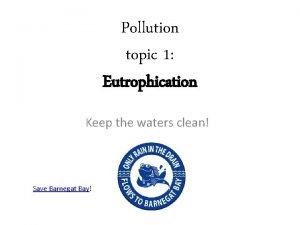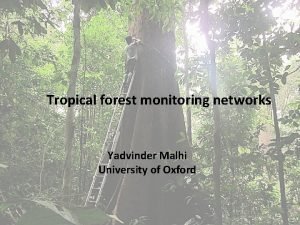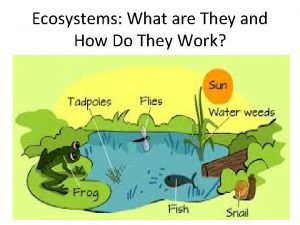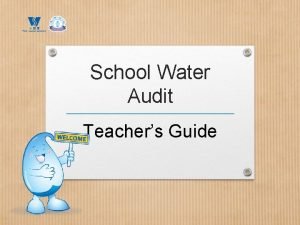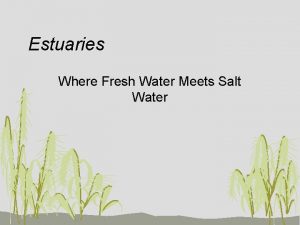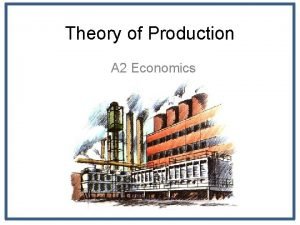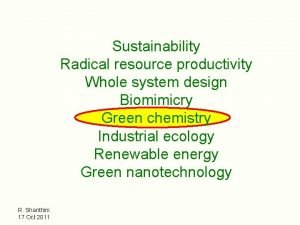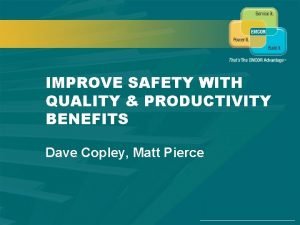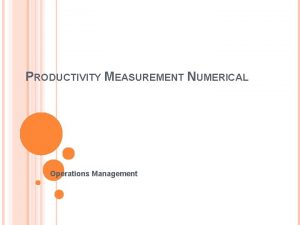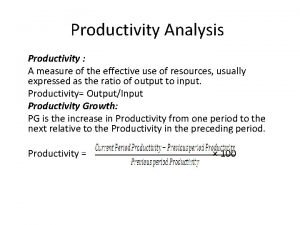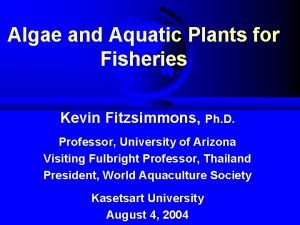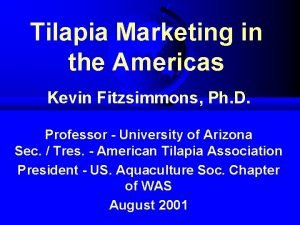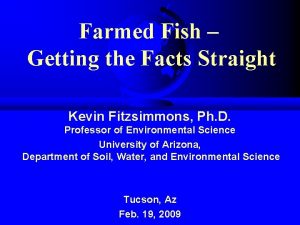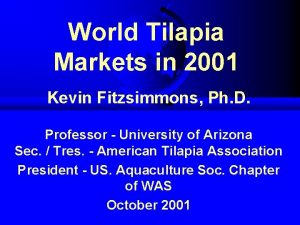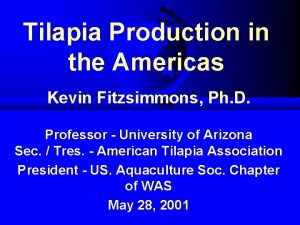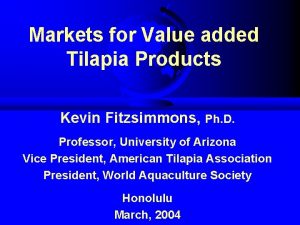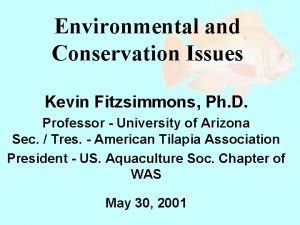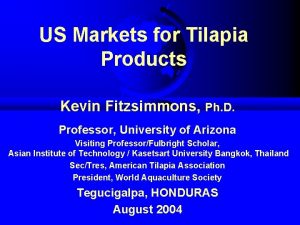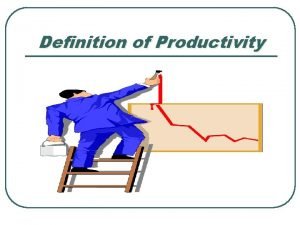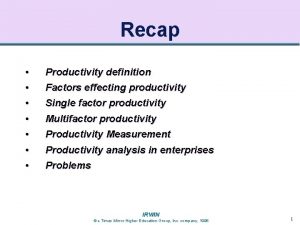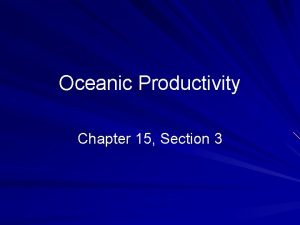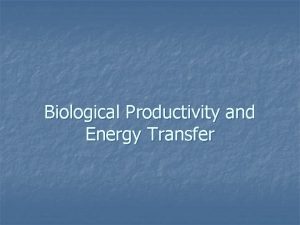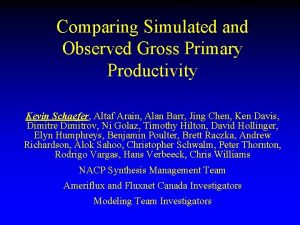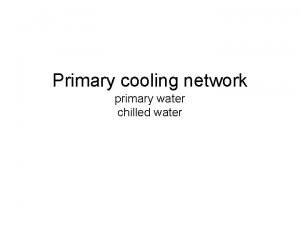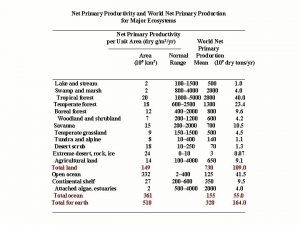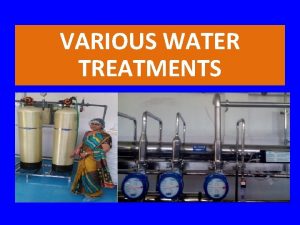Primary Productivity of Water Kevin Fitzsimmons Ph D
























- Slides: 24

Primary Productivity of Water Kevin Fitzsimmons, Ph. D. Professor, University of Arizona Visiting Fulbright Professor, Thailand President, World Aquaculture Society Kasetsart University August 6, 2004

Introduction FRole of algae and aquatic plants as primary producers FRole in fisheries FRole in aquaculture FResearch applications

Role of algae and aquatic plants as primary producers F In most aquatic systems algae (phytoplankton and attached algae) and aquatic plants are the primary source of oxygen and food.

Role of algae and aquatic plants as primary producers F Algae and plants also remove/convert waste from animals and bacteria.

Nitrogen cycle in aquatic systems

Productivity of water can be a measure of fisheries potential FWaters with high productivity are able to support high fish and aquatic animal populations and rapid growth rates (carrying capacity)

Fisheries estimate based on productivity About 10% energy conversion between trophic stages F About 10% biomass conversion between trophic stages F About order of magnitude difference in biomass between trophic levels F

Productivity of water can be a measure of fisheries potential F Tools to measure productivity – Secchi disk – measure of water clarity – Light and dark bottle reactions - measures of photosynthesis and respiration – Fluorometer – measures amounts of various chlorophylls (a, b, c 1, c 2) – Direct algae/plant counts and identification - Filter algae, dry and weigh

Secchi disk Indirect measure that estimates algae population from clarity. Inaccurate method.

Light-Dark Reactions in BOD bottles 1. Use clear exposed bottles to determine photosynthesis rate 2. Use dark covered bottles to determine respiration rate 3. Do arithmetic to determine gross and net photosynthesis

Old style Fluorometer Systems New styles 1. Water sample is placed inside 2. Chlorophyll electrons are excited by light radiation 3. Excited electrons, give off fluorescence as they lose the extra energy

Direct counts, identification and dry weight of algae 1. Sample on counting slide 3. Count cells in randomly (hemocytometer or Neubauer) selected regions, get average 2. Focus on counting grid on low magnification 4. Identify algae, filter, dry, weigh

Primary productivity in fisheries F Productivity as a measure of standing crop F Productivity as measure of potential growth and harvest

Calculations F Standing crop example - Determine that standing crop of algae is 1. 0 g/liter dry weight - Assume most productivity is in top 1 m - Equivalent to 1 kg/m 2 - For 1 ha (=10, 000 m 2) 10, 000 kg algae - Support 1, 000 kg of primary consumer (crustaceans and herbivorous fish) - Support 100 kg of secondary consumer (piscivorous fish, turtles, snakes) - Support 10 kg of top predator (top predators and humans)

Calculations F Productivity example - Determine that algae is fixing carbon at 0. 001 mg CO 2/ml per hour - Equal to 1. 0 mg CO 2/liter per hour - Assume most productivity is in top 1 m - Equivalent to 1 g/m 2 per hour - For 1 ha (=10, 000 m 2) 10 kg biomass hour (120 kg day) - Support 12. 0 kg growth primary consumer per day (crustaceans and herbivorous fish) - Support 1. 2 kg of secondary consumer per day (piscivorous fish, turtles, snakes) - Support 0. 12 kg of harvest per day

Primary productivity in aquaculture F Phytoplankton algae used to feed larval fish, shrimp, mollusks F Phytoplankton also condition water, treating animal metabolic products

Excess primary productivity F Algae blooms that reduce Dissolved Oxygen at night F Algae bloom or plant cover that shade other producers, or interfere with gas exchange, or interfere with access to water F Noxious blooms that cause taste and odor problems

Controls for excess primary productivity F Chemical controls (herbicides, copper, etc) F Mechanical controls (dredges, rakes, backhoes) F Environmental controls (nutrient reduction, shade) F Biological controls (fish, insects) FIntegrated Pest Management

Taste / odor problems F Caused by Cyanobacteria (blue-green algae) F Produce small organic molecules - methyl-iso-borneol (MIB) - geosmin F Cause off-flavor in fish (muddy, grass taste) F Cause odor problem in water (dirty, algae taste) F Usually seasonal

Algae - water quality project

Algae - water quality project F Problem: In summer, numerous complaints from public of bad taste and smell from water F Water utilities spending $1, 000 per year to filter water with activated carbon to remove taste and odor compounds F Utilities asked us for help

Algae - water quality project F Collected data on water chemistry and physical parameters F Took secchi disk readings in reservoir, did light dark bottle tests to determine productivity, and used fluorometer to determine chlorophyll levels F Counted algae and determined recruitment, growth and biomass F Determined nutrient sources from watershed and timing of inputs

Algae - water quality project Determined that problem came from nutrient rich waters from hypolimnion of reservoir F Anoxic water below thermocline accumulated nutrients F When hypolimnion was released to canal, algae bloomed and released geosmin and MIB F Changed water removal from dam, releasing deep water first, removed most of hypolimnion before it accumulated nutrients F Saved utilities $600, 000 per year on water treatment costs F

Quick overview F Algae and aquatic plants provide most productivity to aquatic environments F Algae and aquatic plants can cause problems for humans when out of control F Many new jobs and opportunities managing aquatic systems F Thank you for opportunity to present our research
 Water and water and water water
Water and water and water water Process of primary productivity
Process of primary productivity Gross primary productivity
Gross primary productivity Zone of tolerance
Zone of tolerance Magenta cyan and yellow are the ____ color. *
Magenta cyan and yellow are the ____ color. * Drinking fountain
Drinking fountain Freshwater allowance
Freshwater allowance Water o water
Water o water Estimating products of fractions
Estimating products of fractions A paved blacktop parking lot was built
A paved blacktop parking lot was built Water heat exchanger
Water heat exchanger Fresh water meets salt water
Fresh water meets salt water Warm water rises in a lake. cold water descends.
Warm water rises in a lake. cold water descends. Clil water
Clil water Important of water management
Important of water management Unit 11 water water everywhere
Unit 11 water water everywhere The law of diminishing marginal productivity
The law of diminishing marginal productivity Mission control productivity
Mission control productivity Cradle to cradle design
Cradle to cradle design Steiners model of group effectiveness
Steiners model of group effectiveness Safety quality productivity
Safety quality productivity Productivity=output/input
Productivity=output/input How to measure productivity in operations management
How to measure productivity in operations management Why productivity matters
Why productivity matters What is partial productivity
What is partial productivity

